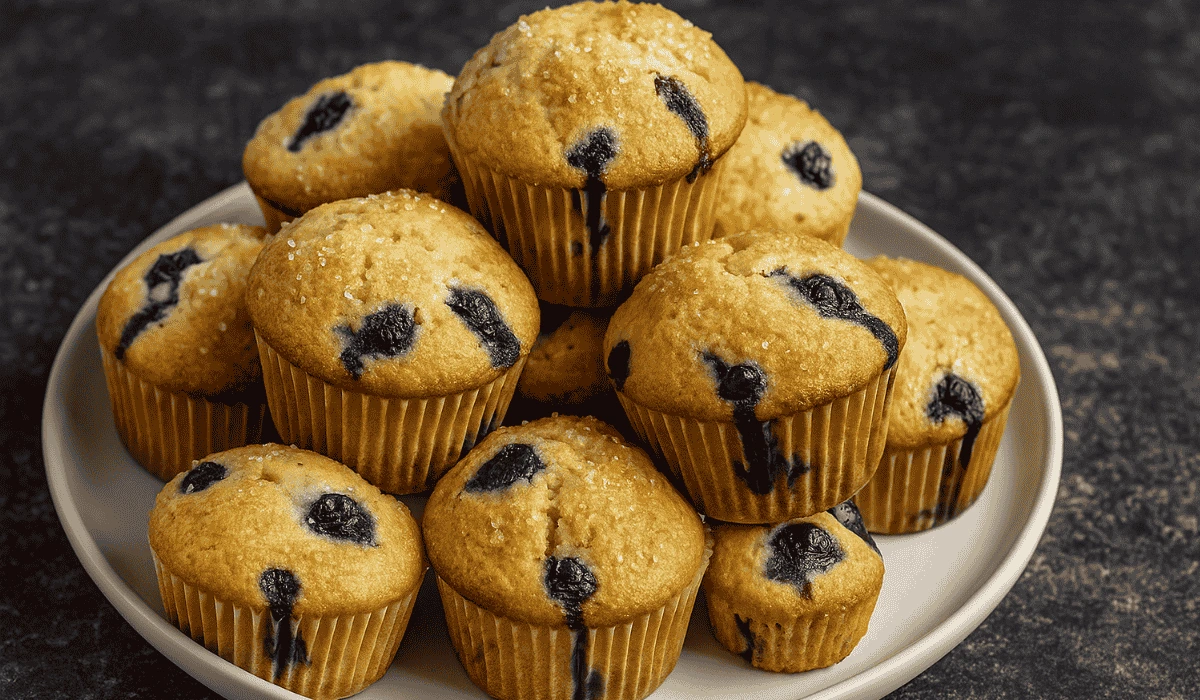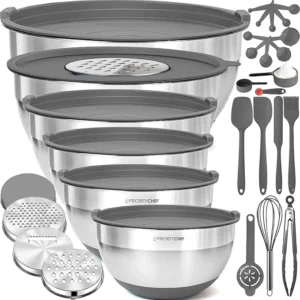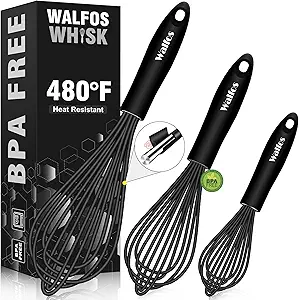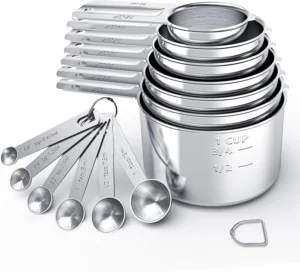There’s nothing quite like the smell of freshly baked blueberry buttermilk muffins wafting through your kitchen. These muffins are everything you want in a morning treat tender, fluffy, and packed with juicy bursts of fresh blueberries. What sets this recipe apart is the use of buttermilk, which adds a subtle tang and keeps the crumb incredibly moist without feeling heavy. Topped with a crisp sugar crunch and just the right amount of golden-brown dome, they look as good as they taste. Whether you’re baking for brunch or stocking the freezer, these muffins deliver bakery-quality results at home with minimal fuss.
Table of Contents
Why You’ll Love This Recipe
These blueberry buttermilk muffins aren’t just good they’re the kind you’ll keep coming back to. Here’s why:
- Bakery-style results at home: Tall domes, golden tops, and that perfect soft, tender center. You don’t need a fancy oven to get them right.
- Moist and flavorful: Buttermilk keeps the muffins soft and slightly tangy, while the blueberries burst with natural sweetness.
- No complicated steps: Simple ingredients, one bowl for dry and one for wet. Easy enough for weekday baking.
- Crowd-pleasing topping: A crunchy sugar crust adds a satisfying bite and gives them that fresh-from-the-bakery feel.
- Make-ahead and freezer-friendly: They store beautifully, so you can enjoy a homemade muffin even on busy mornings.
What really makes these muffins stand out is the balance sweet, but not too sweet. Moist, but not dense. With a touch of citrus if you like, they’re endlessly customizable but perfect as is.
Ingredients Needed For Blueberry Buttermilk Muffins
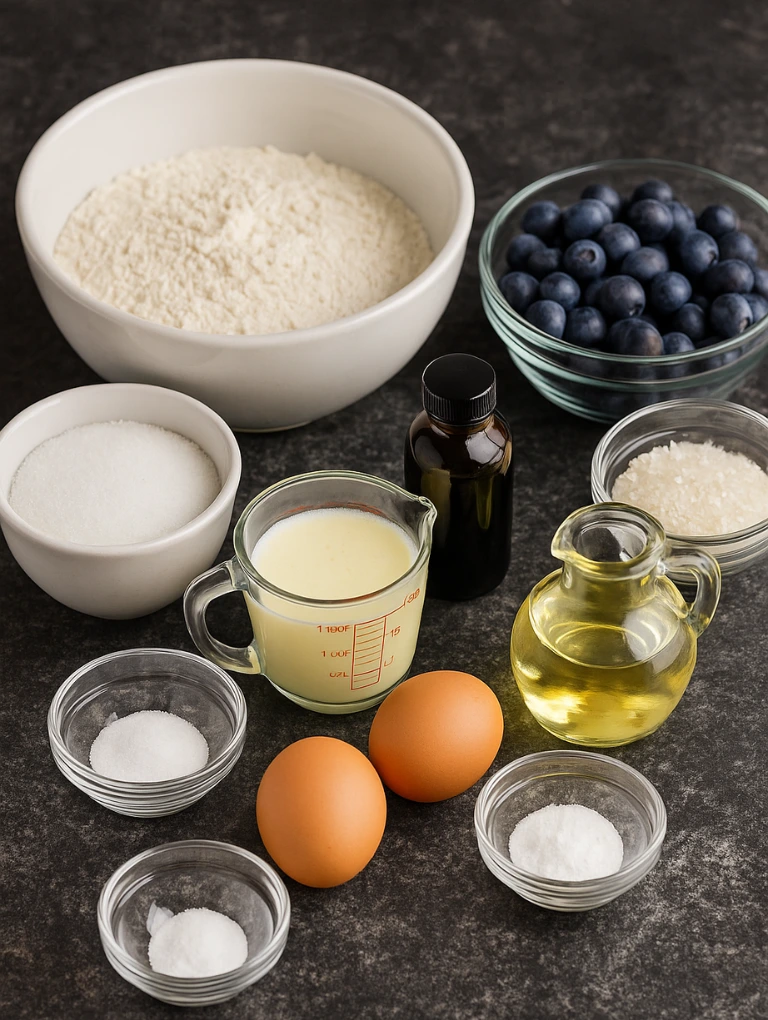
These muffins use simple, everyday ingredients but each one plays an important role in creating the soft texture and full flavor that sets this recipe apart.
For the Muffin Batter:
- 2½ cups all-purpose flour Gives structure to the muffins while staying tender when combined with buttermilk.
- ¾ cup granulated sugar Just enough to sweeten the batter without overpowering the blueberries.
- 1½ teaspoons baking powder Helps the muffins rise high and stay fluffy.
- ½ teaspoon baking soda Reacts with the buttermilk to create a light crumb.
- ¼ teaspoon fine salt Balances the sweetness and enhances all the flavors.
- 1 cup buttermilk, room temperature Adds moisture and slight tang; key for the soft texture.
- ½ cup neutral oil (like canola, vegetable, or avocado) Keeps the muffins moist even after they cool.
- 2 large eggs, room temperature Help bind everything and add richness.
- 1½ teaspoons pure vanilla extract Adds depth and warmth to the flavor.
- 1½ cups fresh blueberries Washed and patted dry. Bursting with juice in every bite.
- 3–4 teaspoons coarse sparkling sugar For sprinkling on top, creating a golden, crunchy finish.
Notes & Substitutions
- Buttermilk Substitute: No buttermilk? Mix 1 tablespoon lemon juice or white vinegar with 1 cup of milk. Let it sit for 10 minutes to curdle slightly.
- Oil vs. Butter: You can swap oil for melted butter if you prefer a slightly richer flavor, but oil will give a moister crumb.
- Frozen Blueberries: You can use frozen blueberries do not thaw. Toss in 1 tablespoon flour before adding to batter to prevent color bleeding and sinking.
- Flour Alternatives: A gluten-free all-purpose blend can work well here, just avoid overmixing.
- Sweetener Options: Coconut sugar or light brown sugar adds a subtle caramel note, though the muffins may turn slightly darker.
How to Make Blueberry Buttermilk Muffins
This recipe is simple, but a few thoughtful steps make all the difference. Follow these instructions carefully, and you’ll have tall, fluffy muffins with golden tops and juicy blueberries in every bite.
1. Preheat and Prepare Your Pan
Preheat your oven to 400°F (204°C). Line a standard 12-cup muffin tin with parchment paper liners. Lightly spray each liner with baking spray to prevent sticking especially around the tops where the batter may rise and spread.
Tip: A hot oven at the start gives the muffins a powerful lift, helping them form those beautiful domed tops.
2. Mix the Dry Ingredients
In a large mixing bowl, whisk together the following:
- All-purpose flour
- Granulated sugar
- Baking powder
- Baking soda
- Salt
Mix until fully combined and no lumps of baking powder remain. This creates an even distribution of leavening, which helps with a consistent rise.
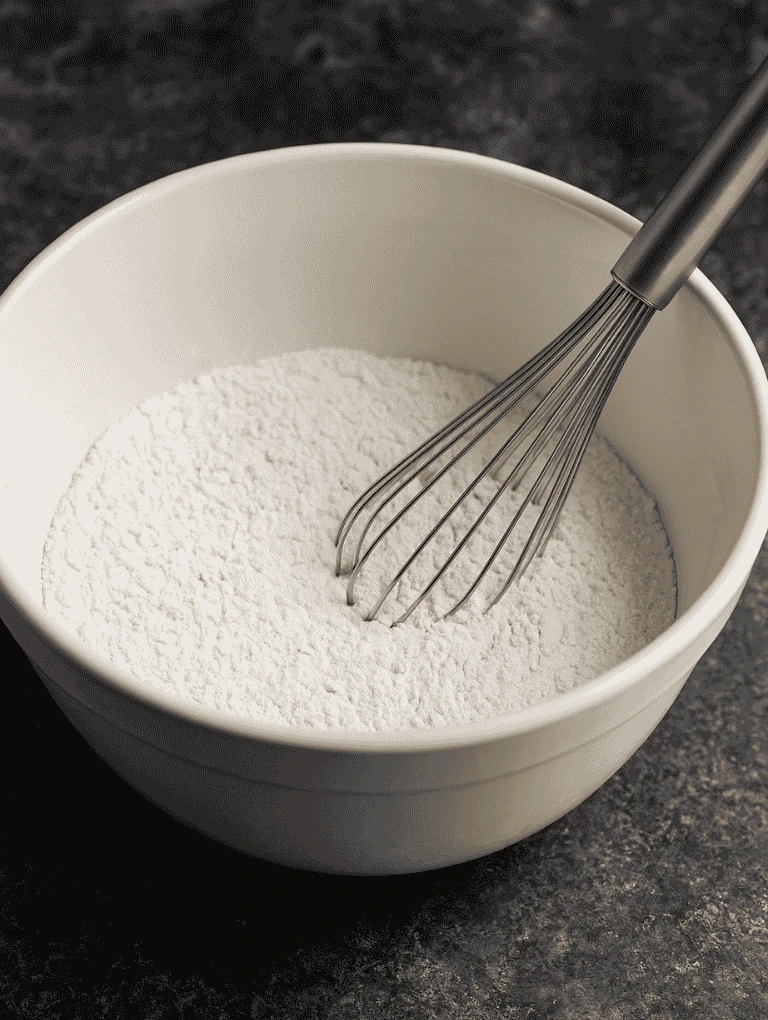
3. Combine the Wet Ingredients
In a medium bowl or large liquid measuring cup, whisk together:
- Buttermilk
- Oil
- Eggs
- Vanilla extract
Whisk until smooth and fully blended. The mixture should look pale and creamy. Make sure your eggs and buttermilk are at room temperature so they combine more easily.
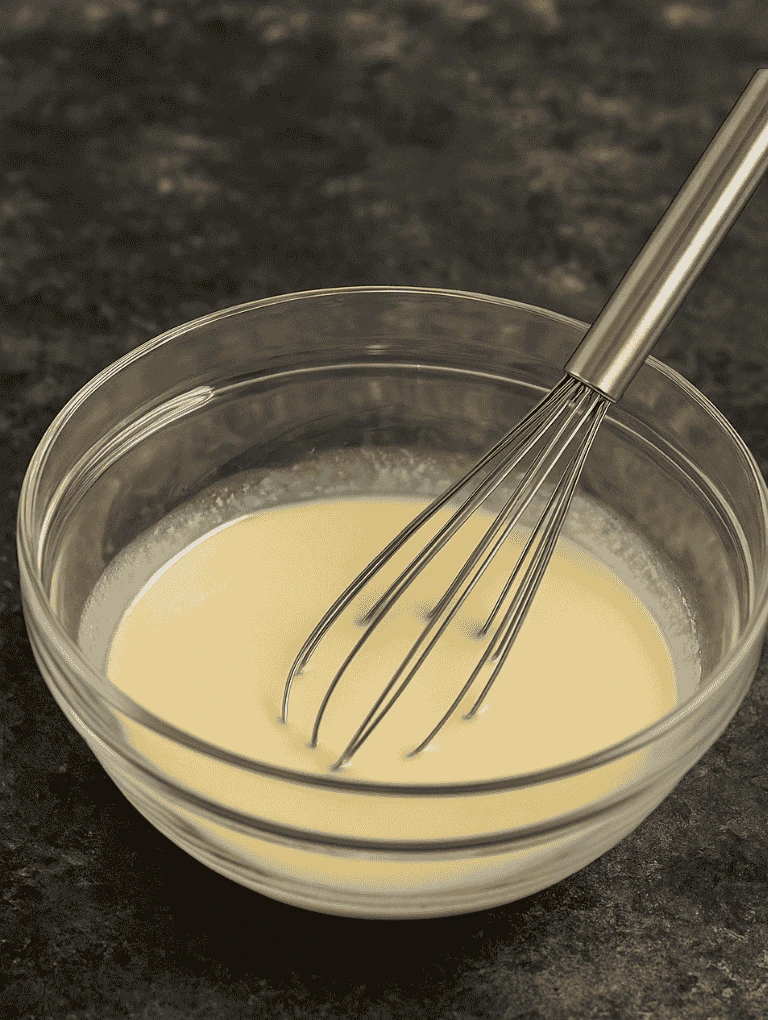
4. Bring It All Together
Pour the wet mixture into the dry ingredients. Using a silicone spatula or wooden spoon, stir gently until just combined.
Important: It’s okay if the batter looks a little lumpy. Overmixing can lead to tough, dense muffins by activating too much gluten.
5. Fold in the Blueberries
Add the blueberries to the bowl. Use a spatula to fold them in slowly and gently. Be careful not to crush them you want whole bursts of fruit, not purple batter.
Optional: If using frozen berries, toss them in a tablespoon of flour before adding. This prevents them from bleeding into the batter or sinking to the bottom.
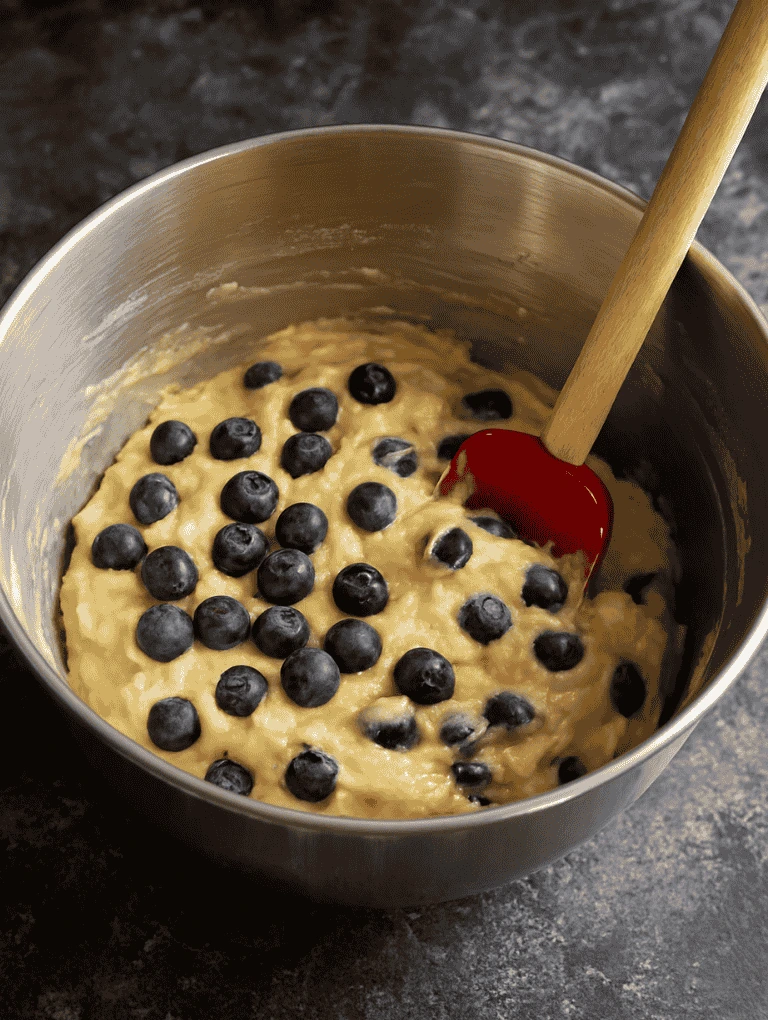
6. Fill the Muffin Cups
Use a large cookie scoop or spoon to portion the batter evenly between the 12 muffin cups. Fill each one nearly to the top this ensures a tall muffin with a domed top.
Sprinkle each with coarse sparkling sugar (about ¼ teaspoon per muffin) for a bakery-style crunch.
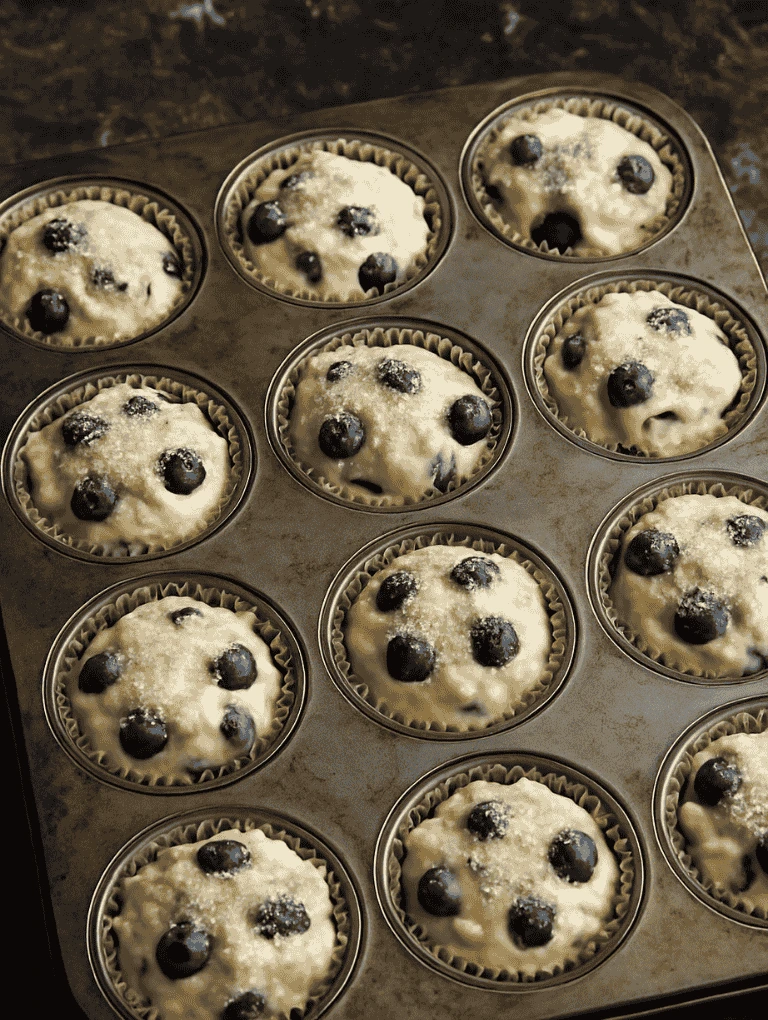
7. Bake to Perfection
Place the muffin tin in the center of your preheated oven. Bake for 22 to 26 minutes, or until:
- The tops are golden brown
- A toothpick inserted in the center comes out clean or with a few moist crumbs
- Muffins spring back when lightly pressed
8. Cool and Store
Let the muffins cool in the pan for 5 minutes, then carefully transfer them to a wire rack to finish cooling completely.
Once cool, store in an airtight container at room temperature for up to 3 days, or freeze for longer storage (details in the next section).
Pro Tips & Troubleshooting
Even simple muffins benefit from expert tricks. These tips will help you get that perfect rise, tender crumb, and even berry distribution every time.
Expert Tips for Better Muffins
- Rub lemon zest into sugar (optional but impactful): If you want a citrus boost, zest a lemon directly into the sugar and use your fingertips to rub them together. This releases fragrant oils and gives your muffins a bakery-level aroma and depth.
- Let the batter rest: Once scooped into the liners, let the batter sit for 15–20 minutes before baking. This hydrates the flour and helps build a better dome.
- Use room temperature ingredients: Cold eggs or buttermilk can cause the batter to curdle or mix unevenly. Room temperature helps everything come together smoothly.
- Start hot, finish cooler (optional advanced method): For sky-high tops, bake at 425°F (218°C) for the first 6 minutes, then reduce to 350°F (177°C) for the remainder. This encourages a rapid initial rise.
- Scoop evenly: Using a large cookie scoop ensures uniform size and consistent baking.
Common Mistakes to Avoid
- Overmixing the batter
Stir until just combined. Too much mixing activates gluten, making muffins dense and rubbery. - Skipping the flour coating for berries (if frozen)
Without it, berries may sink to the bottom and bleed their juice into the batter, causing greenish muffins. - Overbaking
Muffins continue to cook a bit after you take them out. Bake until just golden and test with a toothpick for doneness. - Forgetting to preheat the oven
Muffins rely on a quick rise from the heat. An underheated oven will result in flat tops.
Bonus Trick: Crumb Topping Option
Want more texture? Mix 3 tablespoons flour, 2 tablespoons brown sugar, 1 tablespoon butter, and a pinch of cinnamon until crumbly. Sprinkle this over the batter before baking for a streusel twist.
Serving, Storage & Variations
These muffins are incredibly versatile and easy to enjoy in a variety of ways from casual breakfasts to brunch spreads or afternoon snacks.
Serving Suggestions
Serve warm with a pat of butter or a swipe of lemon curd for an extra zing.
Pair with a bowl of Greek yogurt and honey for a protein-packed breakfast.
Enjoy alongside a cup of coffee or tea perfect for slow mornings or hosting guests.
Split one in half and toast it lightly, then add a bit of jam or cream cheese.
Storage Tips
Room Temperature: Store completely cooled muffins in an airtight container for up to 3 days. Line the bottom of the container with a paper towel to absorb moisture and maintain freshness.
Freezer: Wrap muffins individually in plastic wrap or foil, then place in a freezer-safe bag. Freeze for up to 3 months following USDA’s guidelines on freezing and food safety and FoodSafety.gov’s cold storage chart.
Reheating:
- From room temp: Microwave for 10–15 seconds to refresh texture.
- From frozen: Thaw at room temp, then warm in the oven at 300°F (149°C) for 5–7 minutes.
Tip: For more storage safety tips, check out FoodSafety.gov’s leftover and freezing advice.
Recipe Variations
- Lemon-Blueberry Muffins: Add 1 tablespoon of lemon zest and 1 tablespoon of lemon juice to the batter for a citrusy upgrade.
- Gluten-Free Option: Use a 1:1 gluten-free baking flour blend. Let the batter sit slightly longer to hydrate fully.
- Dairy-Free Version: Substitute buttermilk with almond or oat milk + 1 tablespoon lemon juice. Use a neutral dairy-free oil and skip butter if using the streusel topping.
- Mini Muffins: Use a mini muffin tin and bake for 10–12 minutes for bite-sized snacks.
- Berry Mix: Swap some blueberries with raspberries or chopped strawberries for a mixed berry version.
Nutritional Information
Here’s a breakdown of the nutritional value per muffin. This is based on standard ingredients and yields 12 muffins. If you modify the recipe (using different sweeteners, gluten-free flour, etc.), values may change.
| Nutrient | Per Muffin |
| Calories | 261 kcal |
| Total Fat | 10 g |
| Saturated Fat | 1.1 g |
| Unsaturated Fat | 9 g |
| Trans Fat | 0 g |
| Cholesterol | 32 mg |
| Sodium | 209 mg |
| Total Carbs | 38 g |
| Dietary Fiber | 1.1 g |
| Total Sugars | 17 g |
| Protein | 4.5 g |
Note: Nutrition data is calculated using standard ingredient databases. For personalized tracking or if you’ve modified the ingredients, use trusted tools like Cronometer or MyFitnessPal to verify exact values.
These muffins offer a balanced mix of carbs and fats, with a touch of protein from the eggs and buttermilk. The relatively low saturated fat and moderate sugar content make them a better option than many bakery versions.
There’s a reason these blueberry buttermilk muffins deserve a spot in your regular baking rotation. They strike that perfect balance: moist without being heavy, sweet but not cloying, and easy enough to whip up on a weekday morning. The buttermilk adds a soft tang and helps the crumb stay light and tender, while the sparkling sugar topping delivers the crunch you expect from a bakery muffin.
Whether you’re making them for weekend guests, freezing a batch for busy mornings, or just treating yourself to a better kind of breakfast, this recipe delivers every time.
Frequently Asked Questions (FAQ)
What does buttermilk do for muffins?
Buttermilk adds acidity, which reacts with baking soda to create carbon dioxide this helps the muffins rise and become light and fluffy. It also tenderizes the gluten in the flour, resulting in a softer, more delicate crumb. Plus, it brings a subtle tang that balances sweetness beautifully.
Can I use buttermilk instead of milk in my blueberry muffins?
Yes, absolutely and it’s often the better choice. Buttermilk gives muffins a richer flavor and softer texture compared to regular milk. Just be sure your recipe includes baking soda or enough leavening to react with the buttermilk’s acidity.
Is milk or buttermilk better for muffins?
Buttermilk is better if you want a tender crumb and a slightly tangy flavor. Regular milk works, but it doesn’t offer the same soft texture or rise. Buttermilk also helps create that golden crust on the top of muffins.
What is one thing you should never do to a muffin mixture?
Never overmix. Stirring the batter too much activates gluten in the flour, which leads to dense, chewy muffins. For the best results, mix gently just until the dry ingredients are moistened. A few lumps are okay.
What’s the secret to moist muffins?
Using oil instead of butter can help, as it stays liquid at room temperature and keeps muffins moist longer. Buttermilk also plays a big role by adding both moisture and tenderness. Don’t overbake, and store them properly once cooled.
Do you need baking soda when using buttermilk?
Yes. Baking soda is an alkaline ingredient that reacts with the acidity in buttermilk to produce carbon dioxide, which helps the muffins rise. Even if you’re using baking powder too, a small amount of baking soda is necessary to balance the acid.

